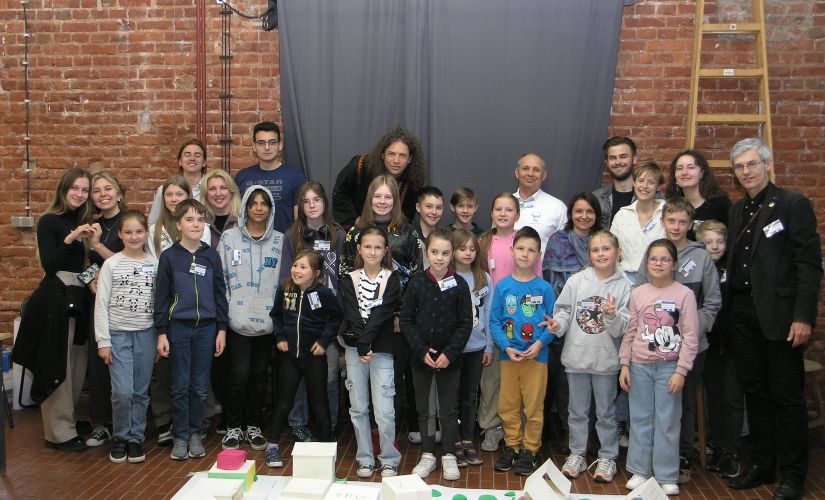As many as twenty-four young Ukrainian architecture enthusiasts aged eight to seventeen accompanied by one adult, Ms. Iryna, who also decided to try her hand at learning by playing, arrived at the Galeria B16. The group was divided by age into teams of four to five, and went on to work on the three thematic modules.
Home is…
The first module in the workshops focused on their understanding of the concept of "home" and its artistic representation. The participants were asked to draw anything that the word "home" brought to mind, and then to talk it over. All of their contributions were incredibly mature and nuanced, and reflected very well just how broad of a concept it really is.
Designing the interiors
The second module was carried out with cardboard models of the interiors in 1:20 scale, using 3D furniture models prepared beforehand by the student who had organized the workshops. The task involved the design of residential interiors and the collaborative process of piecing the different rooms into a functional apartment.
Each team, by selecting the appropriate set of furniture, had to design two interiors for distinct functions. They also had to test out which settings were optimal to make the rooms most comfortable.
They could make decisions about the location of the windows and doors, choose to add extra furnishings, and come up with a color scheme and accessories. The challenging part came when the rooms had to be pieced together into a properly functioning whole.
Designing the building and the town
The third module dealt with the question of composition and spatial form of a building and urban planning all at the same time. The participants were given a set of basic solids, pre-prepared by the organizers, from which they were to put together a building, complete with a roof of a chosen shape and appropriately arranged window and door openings.
This provided an opportunity to introduce them to the concepts of symmetry and asymmetry, rhythm, spatial order, accent, dominant, static and dynamic composition, etc.
Next, the children set the house models, which they had finished and decorated on their own, into a mock-up of a town section, making sure to maintain spatial order and adding greenery, playgrounds, streets, a square, a river, and public utility buildings such as a school and a shopping center.
Having fun and feeling the thrill
The participants worked on their projects for five hours and proved to be real troopers, while the organizers had their back cheering them on, providing real-time feedback on what they came up with, and guiding them to the best possible solutions. Everyone had a great time, albeit quite emotional too. For many participants, we could see that the workshops served as a form of therapy.
One touching moment came when twelve-year-old Maxim reflected on the drawing he had made, which included his loved ones and his buddies. As he said, 'A house can be found anywhere, but home is where the family and friends come together.'
Ms. Iryna made a moving comment, too, when she explained the symbolic aspect of her sketch: the house with the blue curtains in the windows and the yellow lights shining through stood for Ukraine, the grass around it symbolized the home land, and the spreading tree next to it represented the family tree of every Ukrainian family.
We sincerely hope that the young people from the country of our neighbors, hit hard by the war, were leaving our Institute very tired for sure, but full of unforgettable memories.
Acknowledgements
We wish to thank Ms. Iryna Stepas for her support in organizing the event, Tetyana Rohovskaya, our graduate and until recently member of the 'IX Piętro' Student Scientific Association, for her invaluable help in introducing the children to the ins and out of architectural design and her support with translation and interpreting, Mr. Ihor Ivonchik for presenting to the children a concept of an ecological village, and the TUL Media and Communications Office for the souvenirs for the participants.

